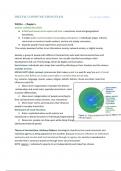DIGITAL COMMUNICATION EXAM 12-04-2023 11H45
WEEK 1 - Chapter 1
DIGITAL COMMUNICATION
● Is fluid and moves across space and time = overcomes social and geographical
boundaries;
● It makes public communication increasingly participatory = individuals shape, reframe,
remix and co-construct media content, and are not simply consumers;
● Expands people’s local experiences and social world.
The society develops further to an information society, network society, or digital society.
Society: a group of people with different characteristics who lead interconnected lives and
interact directly or indirectly as social actors. Are usually classified according to their
development and use of technology, driven by digital communication.
Social actors: individuals who shape their world by reflecting on their situation and the choices
available to them.
SOCIAL FACTS (faits sociaux): phenomena that makes us act in a specific way/ are part of social
structures that define our society and enable or constrict what we do daily.
E.g. customs, language, morals, values, religion, beliefs, fashion, rituals and other rules that
influence social life
1. Macro level :organization of people into distinct
relationships and social roles; typically hierarchical = lead
to power differentials;
2. Meso level: categorization of people according to
their socioeconomic status (income, race, education);
3. Micro level: norms and costumes that influence
people’s everyday interaction.
Dimensions of social structure:
1. Rules: implicated when social systems are
reproduced or altered (routines of individuals/organizations)
2. Resources: people can draw upon while doing things
(attributes/material goods)
Theory of structuration, Anthony Giddens: Sociologists should not see social structures and
individual agency as being opposed to one another, because structures influence an individual’s
autonomy and are also built and maintained through an agency. So, society is reproduced or
transformed in conscious practices through every social encounter.
NOTE: Agency = individual’s capacity to act independently and make free choices
,Practical consciousness = how most agents practices are conducted = act without reflecting on it
Social change causes:
1. Technology
2. Social institutions
3. Environment All areas interrelated, so a change in one area will cause a
4. Population change in all of them.
NOTE: Technology: methods, systems or machines which are the result of creative applications
of scientific knowledge which serve the human needs, transportation, communication and
learning tasks.
Theories on the relationship between technology and society:
1. Determinism
a. Technological determinism- technology independent from society
b. Social determinism- society drives the evolution of technology (beliefs/value)
2. Instrumentalism: states that technology is used by people for different purposes and not
to influence it- considered as a neutral tool
3. Substantivism: states that technology influences how society develops because the
values of technology impact political, cultural and social structures.
4. Social constructivism: states that technology development is shaped by a wide variety of
social cultural, economic and political factors = different people use technologies
differently.
NETWORK INDIVIDUALISM:
● New form of sociability emerging in digital societies.
● Points to one of the most fundamental shifts in society: from a hierarchical and
geographically restricted group to networks of locally and globally connected individuals
DIGITAL DIVIDE: discrepancy between those who have both access to and capability to use
information and communication technologies (ICTs)
Different levels of the digital divide:
- Within and between countries;
- Between urban and rural populations;
- Between generations;
- Between ethnic groups;
- Between men and women.
1st level: division between those who had access to the ICTs and those who did not.
, 2nd level: division develops along the lines of social stratification.
Components of social access:
1. Financial access: whether an individual can afford to be connected
2. Cognitive access: whether people understand technologies
3. Content access: whether there is sufficient material available to people’s needs
4. Political access: whether users have an influence on the institutions regulating
technologies
These problems of accessibility propound pre existing inequalities.
E.G. during the covid-19 pandemic, a lot of inequalities were accentuated- students access to
technology- implementing the need to come up with new strategies to overcome the digital
divides
OLD MEDIA
● Era of legacy media: print media, photos, films, television, radio = all analog technology;
● Is the product of the outcome of mass production;
● Typical communication model is one-to-many;
● Characterized as push-media = messages delivered to the consumers whether they
sought them or not.
NEW MEDIA
● Digital media: websites, social media, computer games, audio, virtual reality;
● It is multimodal- combines text with images;
● Typical communication model is many-to-many;
● Characterized as pull-media = consumers seek out information on a specific topic.
Characteristics of new media:
1. Digital
2. Hypertext
3. Interactive
4. Virtual
5. Simulated
6. Networked:
Audiences are active participants who produce, control, own and share media content =
participatory culture
New media:





